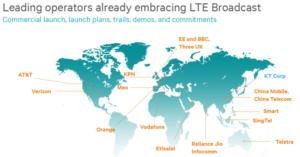Qualcomm was at the show to talk about LTE broadcast rather than making any product or technology announcements. First the company clarified how it is likely to be used.
Spectrum and data connections are relatively scarce resources, even with LTE, but where there is content that is very timely, it can be multicast simultaneously to many viewers. However, operators are likely to limit the number of channels severely and may even have only one. This channel could be used to show major and popular sporting events, breaking news and major public events. An interesting point is that operators that have access to broadcast data can check what the most popular content is on their main channels and switch some of that content to the LTE system.
The broadcast may be only over a limited area – for example, broadcasting content to a sports stadium with additional video resources for attendants. Formula 1 is an obvious application so that attendees can see much more than they would “live”.
Furthermore, sometimes it can be useful to broadcast data (rather than video) that way. After all, it is a much more efficient use of spectrum to send out a small number of Facebook app updates via broadcast (Facebook is said to have 1.5 billion members!) than for each user to have an individual download.
One question that comes up in LTE broadcast is whether the data should use up some of the consumer’s data allowance, but this is a question for the operator and is likely to vary in different parts of the world. Korea Telecom is a leader in the technology and has been working on it for around 1.5 years. Qualcomm believes that its technology (which is a combination of hardware and software) has been used in around 95% of all trials around the world. South America and Africa are still short of trials but there have been dozens around the world, with China a particularly strong region.
Qualcomm has been supplying chips with the technology since Christmas 2013 to help to avoid the “chicken and egg” problem for companies that want to roll out the technology. All of its LTE chips have support, from the low end to the high end.

